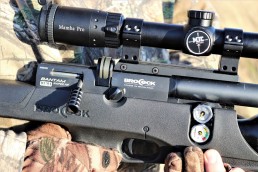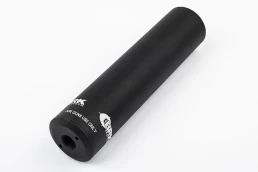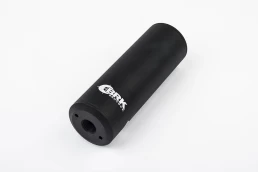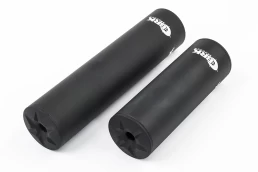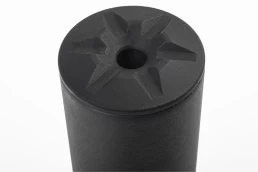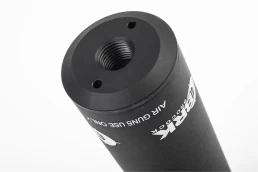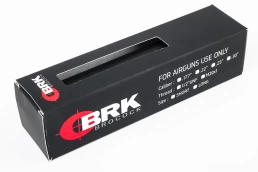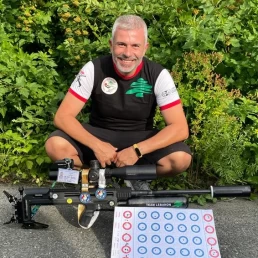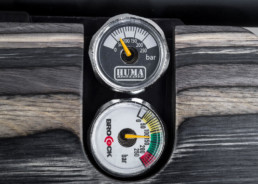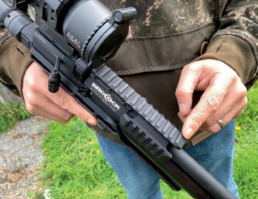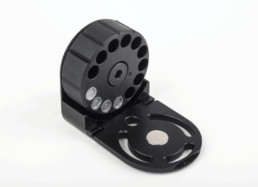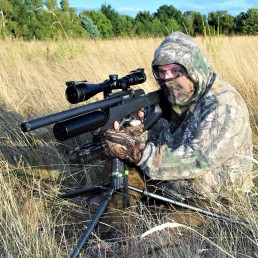NEW BRK Silencers
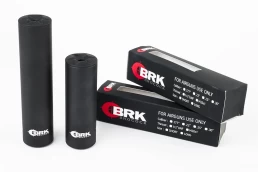
New for 2023, BRK’s MF 1/2" UNF Silencers. The quietest silencer BRK has ever made eclipsing the performance of many existing and more expensive custom brands.
The MF170mm is the long version designed for ultimate silencing and use on shorter rifles such as bull-pup designs and carbines, while the MF 121 is the short, intended to compliment longer full-length rifles. Both silencers have 40mm diameters, which makes them super effective in cutting down muzzle noise. Fits industry standard 1/2″ UNF threads. Calibre specific to .177 (4.5mm) and .22” (5.5mm) Calibre.
It is the perfect accessory for any airgun shooter wishing to make as little muzzle noise as possible.
| MF121 | MF170 | |
|---|---|---|
| Weight | 151g (5.32oz) | 195g (6.87oz) |
| Length | 121.78mm (4.79”) | 170mm (6.69”) |
| Diameter | 40mm (1.57” | 40mm (1.57” |
| Sutability | Airgun Only | Airgun Only |
| Fitment | ½” UNF | ½” UNF |
| Calibre | .177 (4.5mm) and .22” (5.5mm) | .177 (4.5mm) and .22” (5.5mm) |
| SRP (UK) | £110.00 | £115.00 |
Two new super-efficient silencers from BRK, the MF170mm Long and the MF 121mm Short.
Summer Break 12th-21st Aug

BRK WILL BE TAKING A SUMMER BREAK FOR JUST ONE WEEK – STARTING 12TH AUGUST, AND WE WILL BE BACK AT WORK ON MONDAY 21STAUGUST.
Shooting to Victory
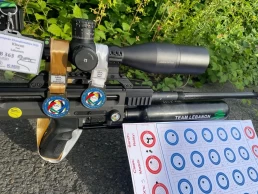
World WRABF Champion and a World Record
BRK Team Shooter, Fady Kiwan has dominated the Benchrest Rimfire and Air Rifle World Championships held in Plzen, Czech Republic, winning two world titles and setting a record score with his BRK Ghost Air Rifle.
The competition, which is sanctioned by the World Rimfire and Air Rifle Benchrest Federation (WRABF) and European Rimfire & Air Rifle Benchrest Shooting Federation (ERABS) saw 237 competitors from 23 countries take part in a range of events between July 26 and August 4.
Fady competed in the Light Varmint 25 metres, Heavy Varmint 25 metres and Unlimited at 50 metres categories. Unlike most other shooters who used highly specialised custom rifles, Fadyused a standard BRK Ghost, only swapping between 17” and 28” barrels and .177 and .22 calibres – a process that takes just a few minutes.
A score of 725.21 points was not only good enough to win the 50m Unlimited world title but set a new record of 247/250 in the process. In addition, he went on to be crowned World Champion in the Three Gun category from his total scores in Light Varmint, Heavy Varmint and 50m unlimited all with the same Ghost.
REGULATED vs UNREGULATED
REGULATED vs UNREGULATED Precharged Pneumatic Air Rifles
What is the difference between a regulated PCP and an unregulated?
Precharged pneumatic (PCP) air rifles are powered by compressed air contained in either an integral air cylinder or buddy-bottle. Although the PCP is the serious airgun shooter’s choice, its concept is inherently simple: a hammer strikes a valve that releases some air to thrust the pellet out of the barrel. The hammer always strikes with the same force, so the amount of air released by the opening valve changes as the rifle’s onboard air pressure behind it drops. This affects the velocity (power) output of the rifle as it progresses through its air charge, resulting in what’s known as a power curve.
The specific shape of the power curve varies according to the rifle’s design. Generally, an unregulated PCP’s power output will rise to a peak before dropping off to the point it needs recharging. A power output that’s dependent on the air rifle’s pressure is not ideal because the pellet’s downrange point of impact (POI) will alter accordingly. Because of this, many airgun makers incorporate an air regulator into their guns. In a ‘regged’ PCP, the power output stays consistent throughout its entire air charge.
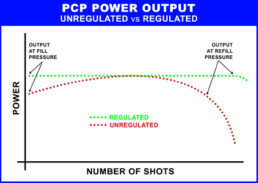
So, which to choose? Although a regged PCP may seem the ideal, unregged PCPs have been around for many years and are still popular. Indeed, much R&D has been undertaken in the PCP world, so the simple ‘knock-open’ valve of old is a far cry from what we see on today’s airgun hardware. The Slingshot hammer/valve set-up used in some unregulated Brocock and Daystate PCPs is one such example of how far unregged PCP design has evolved. Nevertheless, characteristics of unregged and regged systems are an important consideration when choosing a PCP for your specific shooting needs.
UNREGGED PCP
Between the first and last shots of an unregged PCP’s charge of air – its ‘usable’ range – the output will follow a power curve, peaking somewhere around the mid-point of the curve. While the duration of the peak depends solely on the rifle’s inherent design, this part of the curve is referred to as the ‘sweet spot’. It’s where the shot-to-shot consistency – and so the rifle’s accuracy – will be at its best. The longer the sweet spot, the better. Ideally, that is where you want to be doing most of your shooting (and where you should zero your scope).
Of course, you can shoot either side of the sweet spot, but you may well see a slight change in the pellets’ POI. At relatively close ranges this probably isn’t a problem, but it may shift your pellets outside acceptable limits for hunting or competitive target shooting at longer distances. Therefore, with any unregulated PCP, it pays to familiarise yourself with the characteristics of its power curve so that you can compensate for POI shift if required.
Although an unregged PCP lets you shoot throughout its usable pressure range (200 down to 100 BAR in this example), the best consistency, power and accuracy will be obtained by shooting in its ‘sweet spot’ (165 down to 120 BAR in this example)
For example, your rifle may fill to 200 BAR and then, 150 shots later, need a refill at 100 BAR. Let’s assume its sweet spot spans 65 of those 150 shots. Then it would be worth noting on the rifle’s manometer what pressure range relates to that 65-shot section – perhaps between 165 and 120 BAR. If the number of shots you get per charge of air doesn’t bother you, you could choose to fill the rifle only to 165 BAR each time, and always refill it at 120 BAR. Yes, the trade-off is that you’d be reducing the rifle’s shot count, but in return, you’d be getting an output performance on a par with a regged PCP. Plus, by starting at lower pressures, charging the rifle from a manual pump will be less effort, and you’ll get longer periods between scuba tank fill-ups.
REGGED PCP
Where an air regulator is fitted to a PCP, air release is far more controlled for the entirety of the rifle’s charge and there is, therefore, no power curve. Effectively, a regged PCP offers a sweet spot that extends from the first to the last shots of the usable shot range. In some cases, because a regulator deals with air delivery more efficiently, the rifle also returns more shots between fill-ups.
Generally, a regulator system incorporates a secondary air chamber (the plenum chamber) which is designed to operate at a constant pressure. This means that as the rifle’s air pressure drops, the main firing valve always delivers an exactly-metered volume/pressure of air. The benefit of this is that the rifle’s power output is the same, no matter where it is within its charge cycle.
That said, it is important not to let the pressure in the rifle’s main air reservoir drop below that of the regulator’s operating pressure, else the regulator effectively becomes redundant in the airflow chain. Many gunmakers now incorporate an additional gauge on their regged PCPs to specifically indicate the regulator status, like on the Brocock Commander PCP.
The regulated Brocock Commander has two manometers – one for its HuMa regulator’s fixed pressure (top) and one to show the pressure status of the rifle’s main air reservoir
The regulated Brocock Commander has two manometers – one for its HuMa regulator’s fixed pressure (top) and one to show the pressure status of the rifle’s main air reservoir
While ‘managing’ the power curve of an unregged PCP isn’t exactly a headache for most shooters, there’s no denying that the fill-and-forget operation of a regged PCP is more straightforward. However, regulated PCPs cost more than their unregged counterparts, so you have to weigh up their worth in your particular scenario.
FT, HFT and benchrest competition shooters, who seek ultimate precision in every aspect of their sport, may be able to justify the outlay for a regged PCP, but for everyday shooting/hunting assignments, a good quality, unregged PCP is equally as good if you have a full understanding of its power curve.
Yet never dismiss the addition of a PCP regulator as ‘just another thing to go wrong. That may have been the case when air gunsmiths were experimenting with them many decades ago. But just like knock-open systems have evolved, the PCP regulator has also graduated. Specialist regulator manufacturers have risen to the forefront of the airgun industry, with many gunmakers incorporating their proven designs in their regged PCPs. Daystate, for instance, has partnered with the world-renowned HuMa-Air to develop a metering system in their regulated HR Huntsman Regal, Renegade HR and Wolverine R air rifles.
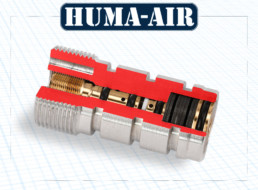
Small and Mighty! Review
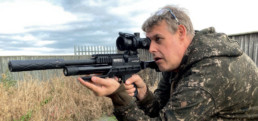
Dave Barham tests the exciting new hunting rifle from Brocock
As soon as I heard about this rifle I knew it was going to be one that I had to get my hands on. It’s not often you come across such
a compact, lightweight hunting rifle, especially one that folds up small enough to put into a small rucksack!
THE LONG AND SHORT OF IT!
There has been a lot of ‘armchair experts’ spreading misinformation that this particular rifle isn’t legal. Well, for a start do you really think that a company as big as Brocock would produce a rifle that wasn’t UK legal? Here is an excerpt from a statement issued by Brocock on the matter; “Brocock confirms that the
Brocock Ranger XR conforms with the UK Firearms Act 1968 in that it is an air weapon and is exempt from defining gun length as specified under Section 5 (1) (aba). Brocock further defines the Brocock Ranger XR as an Air Rifle, which does not exceed muzzle energy of 12 foot-pounds and is therefore not classified as especially dangerous and is exempt from the need for a Section 1 licence under the Firearms Act 1968.” So there you go, it is in fact a
legal airgun, even if the barrel is only 255mm long!
Chris Park Social Media Recommendations
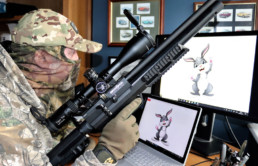
Do you have the lockdown blues? Ranges and clubs closed? Here Chris Park goes through places to (virtually) go and people to (virtually) see
It’s not long until the warmth and light of spring returns but this time of year can be a drag, with a lockdown upon us too it’s never been harder to get out shooting, many of us are trying to make the best of it by shooting on our home ranges or just a bit of vital pest control for a local farmer. All this does mean however many airgunners are unable to partake in the sport they love but that doesn’t mean they can’t keep in touch with the sport with a vast array of social media sites and platforms where fans of air guns can go to keep up to date and in contact with their buddies and the wider shooting community, I’m on a good number of Facebook groups and pages as well as dabbling in Instagram, so I thought I’d share a few of my favourite sites with you.
https://www.facebook.com/BrocockOfficialPage
Brococks own Facebook page, with regular updates direct from the company and details of the latest rifles in the range.
https://www.facebook.com/groups/2570035526403731
Brocock Airgun Owners Group, the largest independent Brocock group on Facebook, here you will find many experienced shooters and a wealth of knowledge, some with a working relationship with the factory. The group is very busy with discussions and will update you on the latest products.
https://www.facebook.com/groups/819534335541728
Brocock Compatto, Bantam, Concept Lite & Commander Owners Group a specialist group for the earlier bolt version of the rifle but which also includes members with the new Brocock XR.
Those are the 3 main groups for Brocock fans, great groups, but if you are looking for something a little more specialised read on as there are countless groups on Facebook for general airgun discussion, almost all do not allow for sale / wanted posts for guns, ammunition, parts, or accessories for firearms due to the Facebook Community Standards which expressly prohibit these sales, as with any group you should read the group rules and follow them to avoid the Admin ‘Ban Hammer’ often brought down without warning! The list below is just a sample of the groups available to you for advice and general shooting chat, but don’t forget if you can’t find the group you’re looking for, you could always start your own!
https://www.facebook.com/groups/304919272895108/?multi_permalinks=3642617405791928
AirgunTV
https://www.facebook.com/groups/351221505224875/?multi_permalinks=1372002523146763
Airgunology
https://www.facebook.com/groups/airgungurus/?multi_permalinks=2155064244629788
AirgunGurus
https://www.facebook.com/groups/1095910907267591
Honest Gun Reviews
https://www.facebook.com/groups/533939790100899
Air Rifle Enthusiasts
https://www.facebook.com/groups/1744589079091832
AIR GUNNER UK.
https://www.facebook.com/groups/1234512020018122
Airgun World
https://www.facebook.com/groups/1143034299207072
Flat Broke Airgunner
https://www.facebook.com/groups/1077801215731796
Air Rifles UK
https://www.facebook.com/groups/572602580277042
Air Hunter U.K.
https://www.facebook.com/groups/2042812652615265
Air gunners with passion target shooters and hunters
https://www.facebook.com/groups/691598510996726
Westcountry Air Rifles
https://www.facebook.com/groups/1665972373694392
Shooting UK
https://www.facebook.com/groups/184370478999357
Line of Sight Shooting Group
https://www.facebook.com/groups/1207664592739394/
Mavericks Airgun Talk
https://www.facebook.com/groups/142755936597174/
Air Rifles UK
https://www.facebook.com/groups/1593212404329331/
U.K. Shooters Unite
https://www.facebook.com/groups/189033185689842/
The Gun Lounge
https://www.facebook.com/groups/2321807924708108
Pimp my Air Rifle
https://www.facebook.com/groups/HUNTING.down.prices
HUNTING……..down prices!
https://www.facebook.com/groups/120936275305002
LETHAL AIR Airgun Hunters
https://www.facebook.com/groups/309523832818698
Fieldsports For All
https://www.facebook.com/groups/1991517344459572
ALL THINGS AIRGUN
https://www.facebook.com/groups/airrifleshooting
POI Air Rifle
https://www.facebook.com/groups/131205725685
BASC (supporters group)
https://www.facebook.com/groups/115505319101840
NARA – National Air Rifle Association
https://www.facebook.com/groups/1011285322259345
Kevs getting to know your airguns
https://www.facebook.com/groups/851938148524218
Yorkshire Hunting and Field Sports
https://www.facebook.com/groups/856324351099747
Air Hunters UK.
https://www.facebook.com/groups/458105601363296
Pellet pushers of the world unite II
https://www.facebook.com/groups/421602212068098
Shooting Adventures
If you are into something more specialist to suit a particular branch of the sporting disciplines, or something to add to your set up, don’t be shy about searching out some of the groups for support and advice from firsthand users, below are some examples in no particular order.
https://www.facebook.com/groups/1888907281337886/
MTC / Optisan Optics Owners Club
https://www.facebook.com/groups/nvuk.nightvisionuk
Night Vision UK
https://www.facebook.com/groups/1431006563822393/
Huggett Moderator Owners
https://www.facebook.com/groups/1109737622526888
CARM
https://www.facebook.com/groups/908558065923417
UK Benchrest Target Sport Enthusiasts
https://www.facebook.com/groups/belltarget
Bell Target 6 & 7 Yard Air Rifle Enthusiasts
https://www.facebook.com/groups/653370445125690/
Preesall Air Rifle Range
https://www.facebook.com/groups/1542783956025531
Mad Air outdoor air rifle range Pilling
https://www.facebook.com/groups/511300516378969
Long Range Airgunners
https://www.facebook.com/groups/207819235982252/
Air Rifle Hunters Recipe Group
https://www.facebook.com/groups/954235824623568
VERMIN BASHERS……
https://www.facebook.com/groups/200610323900311
Air Rifle Vermin Control UK FEATHER and FUR
https://www.facebook.com/groups/theBFTA/
The BFTA (British Field Target Association)
https://www.facebook.com/groups/1538796829720355
UKAHFT
https://www.facebook.com/groups/444909922605086
UK Crow & Pigeon Hunters
https://www.facebook.com/groups/1729863907277740
UK and Ireland squirrels The Grey Area Group
https://www.facebook.com/groups/273469082988454
UK rat squirrel and bunny hunting
https://www.facebook.com/groups/2267805239967337
Pest control (air gunners) UK
https://www.facebook.com/groups/249087698548813
Eaglevision
https://www.facebook.com/groups/1687570314609905
Game for the Table
There’s hours of online entertainment for the lockdown on Facebook which will link you to other platforms like YouTube, Instagram, MeWe to name but a few, all this means there’s no reason to lose touch with your favourite shooting sports.
Chris Park,
Admin & group owner,
Daystate Owners Target & Shooting Group.
How to use a feeding station to control grey squirrels
Grey squirrels are a destructive invasive species that are having a serious impact on trees and vulnerable wildlife, including red squirrels – Mat Manning explains how to use a feeding station to bring the greys to book.
WHAT TO USE
Most feed hoppers are of a similar design to bird boxes but with a feed tray in front of an outlet hole at the front. The sides of the tray should be low enough to allow you to take clear shots at squirrels if they decide to settle in there. Vulnerable areas of the feeder, particularly around the outlet, should be reinforced with metal to protect against gnawing. Good quality feeders can be purchased online but it is easy to make your own.
Wheat is the most affordable bait to load your feeders with but it lacks attraction if there are other food sources nearby. Maize and sunflower seeds have more appeal and, although more expensive, peanuts will get grey squirrels queuing up at any time of year.
WHERE TO TARGET
Focus on the areas of your woodland shooting permission where you have seen the most squirrels. In the absence of frequent sightings, look for other signs such as squirrel’s dreys and trees that have been damaged by the rodents’ bark-stripping. Likely places include areas around tress such as oak, hazel, beech, sweet chestnut and walnut, which provide natural food, and areas where dense patches of ivy provide shelter for squirrels.
GETTING STARTED
Attach your feeder to a tree at a height that keeps it well clear of the ground and marauding badgers but is slow enough for you to refill comfortably. Fill it with bait and leave it alone for three or four days. Songbirds are likely to be the first visitors and their comings and goings will attract squirrels.
When you return to check the feeding station the feed should already be going down. Refill and leave it for a few days. After a week, the feed should be going down quite steadily – now is the time to build your hide. If your feeder has not received any attention after a week, move it to another spot.
KEEPING CONCEALED
You only need a very basic hide to keep you out of sight when shooting grey squirrels from a feeding station as the rodents are usually too distracted by the food to take much notice of what’s going on around them. It should be positioned between 20 and 25m from the feeder and afford you a clear view of feeding squirrels.
My usual choice is a net hide propped up with purpose-made hide poles. I like to have a substantial backdrop behind it – either a bank, bushes, a thick tree trunk or branches – to keep my silhouette hidden. After constructing a hide, I leave it in position for another week. During this period the squirrels will grow in confidence at the feeder, attract even more of their mates and learn to ignore the hide.
GUN, SCOPE AND AMMO CHOICE
Any accurate airgun, either sub-12ft/lb or high-power is suitable for controlling grey squirrels at a feeding station. Recently I have been testing the new Brocock Safari, which has impressed me so much I have now ordered a .22 which churns out a muzzle energy of just over 46ft/lb. Such a powerful airgun is not essential when targeting squirrels at relatively close range but it will give me extra reach if I need to take wary squirrels or avian quarry at range. My scope of choice is as usual the MTC Mamba scope. In my opinion, this versatile little optic is as close as you can get to perfection for airgun pest control.
THE SHOOT
The first shoot usually takes place about a fortnight after the feeder is put in position, by which time plenty of squirrels should be visiting with confidence. Fill the feeder the day before you intend to shoot because you don’t want to have to disturb it when you arrive.
Early morning sessions tend to be very productive as squirrels tend to wake up feeling hungry, although evening sessions can also be good. Head straight to the hide and settle in as quickly and quietly as possible. Make yourself comfortable as you may have to be patient. I like to use shooting sticks for extra support when taking sitting shots from a hide.
When a squirrel arrives, don’t be in a rush to take a shot. Give it time to take some feed from the tray and settle down to eat it – this will ensure that you are presented with a static target, which makes it much easier to ensure clean shots to the head. There is no need to break cover to retrieve dead squirrels until the end of the session – their mates are usually too interested in the feed to worry about the bodies beneath the feeder.
KEEP IT GOING
The first session on a feeding station is usually the best and can often yield bags of ten or more in just a couple of hours. When you leave the hide, refill the feeder and make sure you keep it filled until you return to shoot again – a week is about the right amount of time to leave between visits.
Your second session should yield less squirrels than the first, and numbers should continue to decrease until you draw a blank. When this happens and it appears that the only visitors are wild birds, it is time to move the feeder to another spot and start over again.

New Brocock Magazine System
Say hello to the arrival of a slick, new magazine system fitted as standard on new Brocock XR rifles that offer a greater payload and easier loading!

Last Orders for Christmas!
The company will be standing down for Christmas and new year break on 23 December unit 4th January. The last date for service and warranty collections will be 17th December.
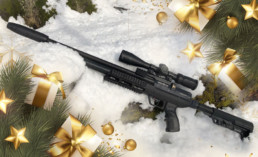
Yesterday was a good day
Yesterday was a good day. I’ve only been in my role as Brocock’s hunting adviser for a few weeks when a courier turned up with a brand new regulated Brocock Sniper HR. If that wasn’t enough, there was an MTC Mamba Pro to put on top of it.
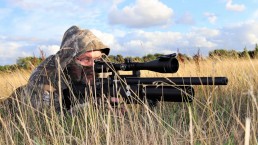
If I’m honest, I’m still working out what a hunting adviser does. I’ve spent some time on the internet and found several blokes who describe themselves variously as ‘brand ambassadors’ or ‘resident hunting experts’.
From what I can work out, their job entails a lot of shooting and having photos taken of themselves looking very serious in the woods or a field. That seems pretty good to me. I’m always out shooting and I’m handy with a camera, the idiot-proof kind, too.
I’m sure the folks at Brocock are expecting a little bit more than that though, so my plan is to put their rifles through their paces and let them know what I like and don’t like. I hope that’s good enough.
I had the Mamba Pro scope attached to the rifle before the Parcel Force van had even backed out of the drive and have been itching to give the combination an outing ever since. God, worked dragged on today but eventually I was able to down tools, put on my shooting gear and get out in the last couple of hours of daylight, my new Bantam HR Sniper under my arm.
As if getting to play with new Brocock rifles and MTC scopes isn’t lucky enough, I’m also fortunate to have plenty of shooting permissions, several of which are within a 30 minute drive of home.
However, I begrudged every wasted minute spent travelling so planned to go to my nearest permission which is about five-minutes away.
The main part of the farm is a plant nursery where shrubs and flowers are grown on before being sent off to garden centres. The rabbits eat their way through a small fortune each year – apparently, they have a particular fondness for holly. I don’t know, but I get the impression the place is run on a bit of shoestring and the pennies count so every rabbit I’m able to remove is one less to eat into the farmer’s slender profit margin. Its also one of the few permissions where the farmer asks me to leave him a couple of rabbits for the pot whenever I can.
The weather today was fantastic. Its been too hot this summer, for me at least, and today, whilst it was up in the mid-20s again, the humidity was low and there was a gentle breeze to move the few clouds around.
I arrived at about 7.00pm and the farm was nice and quiet. I’d sent the farmer a text to let him know I was coming and left the keys in the truck in case he needed to move it.
I planned on targeting a large warren in a field that has been left to grow wild. If only the rabbits stayed and ate the grass there, they’d be left alone, but the warren seems to be the launch pad for their raids on the plants and shrubs.
The wind direction was perfect, right in my face. There’s very little cover in the field to creep about in but the grass has been left to grow high. Spotting rabbits to stalk would be nigh on impossible and there was every chance I’d spook them before I saw them.
Instead, as I have done on many other occasions, I planned an ambush, which meant a long walk around the entire perimeter of the field to get into position. I had two locations in mind. On one of them I’d be able to lie at the edge of the long grass and shoot from a prone position. The other meant having to sit amongst the grass so I fitted a bipod to the Bantam HR Sniper and took my shooting sticks as well.
As I started off, I could see three or four rabbits on the far side of the field, probably 300 metres away. They’d been shot at enough times in the past to be on the lookout for danger and one glimpse of me convinced them to slowly disappear.
I wasn’t too bothered. I’ve always operated on the theory that its better for rabbits to pop back into their holes out of a sense of precaution rather than panic. In my experience, they usually reappear before too long. On the other hand, spook a rabbit at close range and it will disappear underground in a flash and likely stay there for the rest of the day.
Anyway, I had plenty of time so continued walking slowly and, I hoped, stealthily towards where the rabbits had vanished. Fifteen minutes or so later and I was in position in the spot where I’d be able to lie prone.
Gratefully I sank to the ground, the Bantam HR Sniper on its bipod in front of me. Brocock had sent me the steel bottle model, but even so I had found it light and comfortable to carry. The cut away stock makes a convenient handle, but I plan to fit a sling at some point anyway.
As usual, I managed to lie down in a spot that had a few spiky thistles in exactly the wrong places, so spent a few minutes wriggling around to get comfortable. At last I was happy with my position on the fringe of the long grass, confident that it, along with my camo hood, face veil and gloves would make me pretty much invisible.
From experience, I expected any shots to present themselves anywhere from 25 to 35 metres away. I’d bunked off work a little early yesterday so I could zero the Bantam HR Sniper and Mamba Pro and work out my hold over points.
I zero most of my sub 12 ft. lbs. rifles at 30 metres. As a .177, the Bantam HR has the same aim point at 20 and 30 metres with half a mildot of hold over at 35 and a full mildot at 40. Practice had gone well and shown the Bantam HR Sniper had a fondness for Daystate Sovereign pellets, stacking them on top of each other at any distance.
Peering through the clear lens of the Mamba Pro 5-30×50 I was confident of taking any rabbit that showed itself cleanly and humanely. I dialled the magnification on the scope to 12x and twiddled with the parallax dial to fine tune the image for maximum crispness.
Then, resting on my elbows, it was just a case of waiting.
It didn’t take long for a couple of tiny kits to re-emerge. They couldn’t have been more than a few days above ground. I’m not squeamish about shooting small rabbits, they grow into larger ones after all, but I wanted a fully grown adult to christen my new rifle and scope.
So I waited, watching the baby bunnies through the scope and practising laying the SCB2 reticle over their heads and mentally at least, placing perfect shots. Before long, my back and shoulders started to ache. I was considering a move to my second location when a fully grown rabbit obliged by hopping out of the hedgerow right in front of me.
I froze and it seemed to be staring me right in the eyes. I don’t know whether it could see me or not, but it seemed reasonably relaxed and after a few seconds hopped a couple of metres to my left. It sat there in profile as I manoeuvred fractionally into position and looked through the scope.
I eased the Bantam’s safety catch off, careful to stifle any click it made, and held my breath, picking a small dark patch behind the rabbit’s eye to aim at. Before I knew it, the trigger seemed to go off by its own volition. The rabbit leapt forward a couple of feet and I had that moment of trepidation, thinking I’d somehow missed from 30 metres and wounded my quarry.
It was only a moment though as I could see the rabbit laying on its side, stretching out its legs and splaying its toes before laying perfectly still.
I could have stayed in position and would probably have had another shot or two – I have in the past – but I’d been laying down for too long so I collected the rabbit, confirmed a clean hit exactly where I aimed and squeezed its belly to empty the bladder before putting it in my game bag.
The Bantam HR Sniper and MTC Mamba Pro combination were off to a great start.
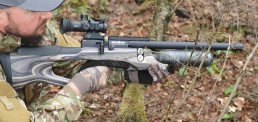
My second ambush position was a short walk away, located just along from the corner of the field where the rabbits burrowed into a sandy bank.
The long grass once again gave me excellent cover, but this time I had to sit amongst it and shoot over the top, making my bipod redundant. The prospect of sitting rather than laying down was an attractive one though.
I’d seen no rabbits on my approach which wasn’t much of a surprise as I hadn’t had a chance to fit a silencer to the Bantam HR Sniper and although the barrel is fully shrouded, the sound of my last shot would have carried.
I eased down into position about 25 metres from the sandy bank and set my trigger sticks up to give me a perfect position for where I hoped the rabbits would appear. Once again, I settled down to wait, insects buzzing around in the last hour or so of daylight.
From the comfort of my position, and with the advantage of the shooting sticks, I dialled the Mamba Pro down to 5x so I could scan the hedgerow more easily. About 60 metres to my left – too far for a shot – two fully grown rabbits emerged and settled down to nibble the grass. I knew that if I tried to inch closer, they’d disappear before I’d even moved a yard.
I spent some time watching the pair, willing them to get closer. As is often the way though, they did the opposite and edged further way. When I swung the Mamba Pro back to the hedgerow in front of me a rabbit had materialised out of thin air. No matter how many times it’s happened, I continue to be amazed every time. It’s almost as if they wait until you’re not looking to show themselves.
The rabbit was in fact a little to my right and about 28 metres away. Once again, I shuffled into position, taking care not to clatter the trigger sticks, and placed the SCB2 reticle on the rabbit’s head. It was looking straight at me. I prefer to take rabbits side on with a 12 ft. lbs. rifle but after waiting a minute or so, peering through the scope, the rabbit refused to budge so I took the shot. Once again, the Bantam HR Sniper cracked and the pellet found its mark, killing the rabbit instantly.
He joined the one in my game bag and I made my way back to the farmer’s house, glad it was still early enough to catch him up so I could give him the rabbits and bask in his appreciation of two less to plunder his plants.
